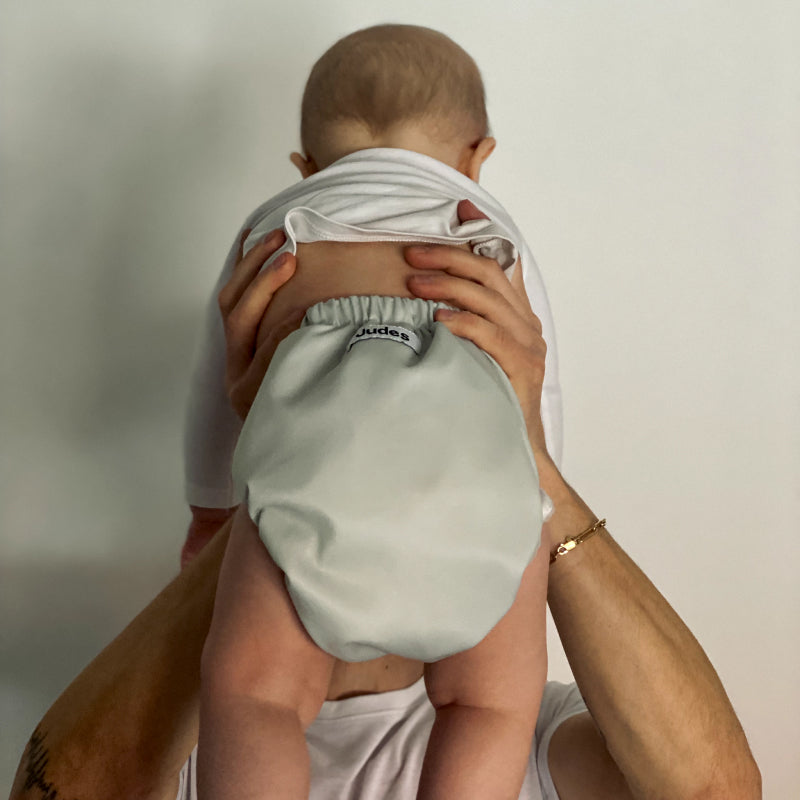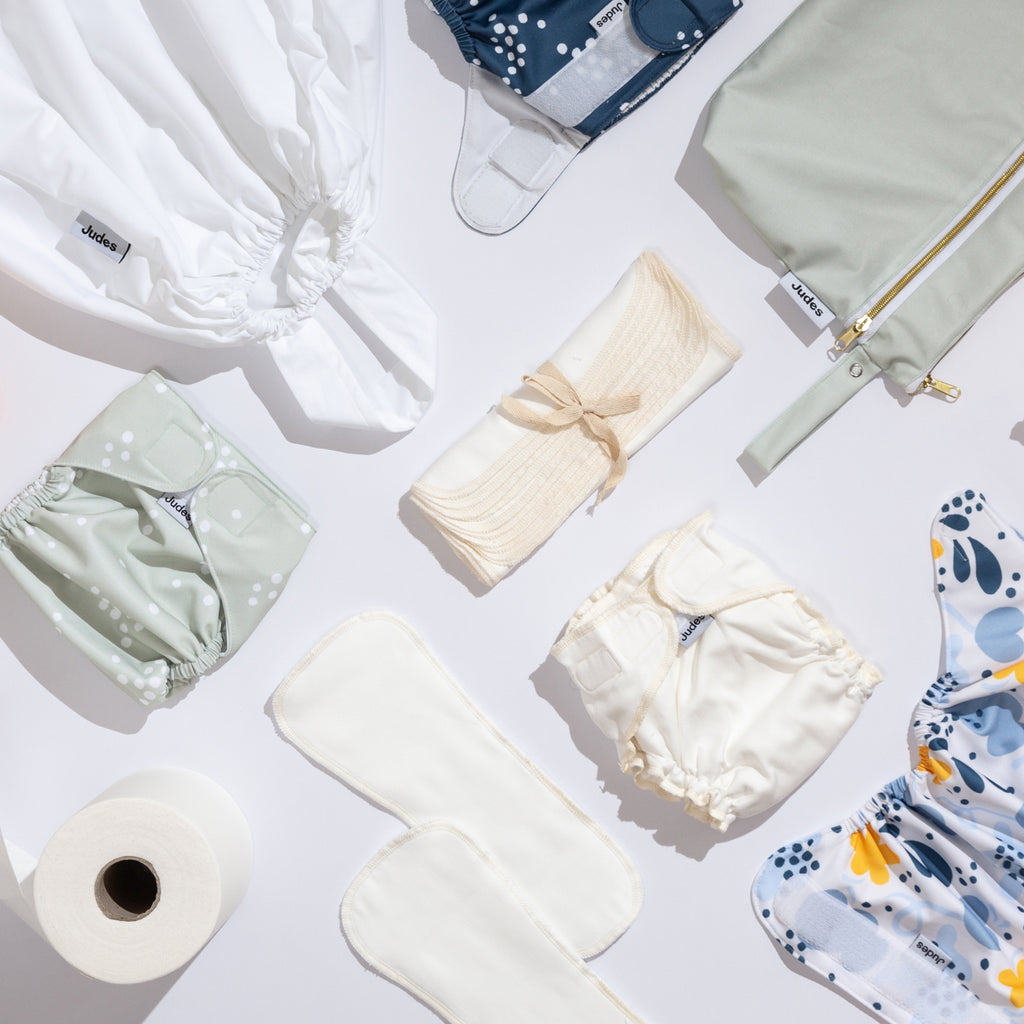Elimination Communication: The Natural Way to Fewer Diapers
Updated on:
Photo by @ablondegirlsjourney
Have you ever heard of elimination communication? This method, also known as “diaper-free” or “natural infant hygiene,” goes far beyond simple diaper changing. It is based on observing and communicating with your baby to recognize and respond to their need to go before they use a diaper.
What is elimination communication? Elimination communication is a method of natural infant care where parents learn to recognize and respond to their baby's signals by holding them over a potty or toilet to encourage elimination. This practice promotes communication between parents and their child and can help reduce the use of diapers.
The concept of elimination communication is by no means new. For centuries, cultures worldwide have practiced this method long before disposable diapers became the standard. In recent years, elimination communication has experienced a renaissance as more and more parents look for ways to strengthen the bond with their child while also conserving the environment.
In the following sections, we will take a closer look at how elimination communication works, what benefits it offers, and how you can integrate this practice into your daily life with your baby. Whether you want to completely forego diapers or use elimination communication as a complement to eco-friendly cloth diapers, this method offers an enriching experience for you and your baby.
Introduction to Elimination Communication
Elimination communication, often referred to as “diaper-free,” is a method where parents try to recognize and respond to their baby's elimination needs before the baby uses a diaper. This practice is based on the assumption that babies naturally do not want to eliminate in their diaper, sleep area, or on their caregivers and are capable of giving signals when they need to go. Parents learn to interpret these signals and hold their baby over a potty, toilet, or other suitable location.
Historical Background
Historically, elimination communication is not a new concept. Before disposable diapers became popular in the 20th century, it was common in many cultures worldwide to hold out babies. In some countries, it remains the norm to this day, and parents start paying attention to their baby's elimination signals shortly after birth and act accordingly. This practice was not only based on economic or environmental considerations, but also on a deep understanding of non-verbal communication between parents and child.
Modern Practice
Today, elimination communication is experiencing a revival as more parents seek ways to live more environmentally consciously and strengthen the bond with their child. The modern interest in elimination communication is also a reaction to the rising costs of disposable diapers and the concern about the environmental impact of diaper waste. While completely avoiding diapers can be an option, many parents use elimination communication in addition to cloth diapers to reduce diaper usage and provide their child with more comfort.
Elimination communication requires attention and commitment from parents but offers numerous advantages, including a stronger parent-child bond, health benefits for the baby, and a reduced ecological footprint. It is a flexible practice that can be adapted to the individual rhythm and needs of each baby and represents an enriching experience for the entire family.
How Does Elimination Communication Work?
Elimination communication is based on the communication and understanding between you and your baby. It involves recognizing your baby's natural elimination signals and responding accordingly. Here are some basic steps and tips to start with elimination communication.
Recognizing a Baby's Elimination Signals
- Restlessness: Many babies become restless or start kicking when they need to go.
- Specific Sounds: Some babies make specific sounds or become noticeably quiet.
- Facial Expressions: Pay attention to facial expressions like furrowed brows or a concentrated look, which may indicate your baby needs to go.
- Timing Patterns: Often, babies develop certain times when they tend to need to go, such as shortly after nursing or waking up.
Different Elimination Communication Positions
- Classic Squatting Position: Hold your baby so that their back leans against your stomach, and support their thighs in a squatting-like position. This position is well-suited for elimination communication over a toilet or potty.
- Holding Over the Toilet: For older babies, you can hold them over the toilet, allowing them to support themselves with their hands on you or the toilet seat.
- On the Lap: For younger babies, elimination communication can also be done on your lap by placing one hand under their thighs and supporting their back with the other hand.
Tips for Successful Elimination Communication in Daily Life
- Regularity: Try to hold out your baby at fixed times to develop routines, such as after waking up or after nursing.
- Relaxed Attitude: Stay calm and patient, even if it sometimes doesn't work. Stress and pressure can be counterproductive.
- Adaptability: Be flexible and adapt the practice to your baby's needs and developmental stage. What works one day might not necessarily work the next.
- Supportive Tools: Use supportive products like Judes cloth diapers, which can be quickly and easily changed when elimination communication doesn't fit into your daily routine.
Elimination communication is a practice that requires patience and attention, but due to the close bond it fosters and the benefits for both the baby and the environment, it is a rewarding experience for many families.

Photo by @cafema.illustration
Benefits of Elimination Communication
Practicing elimination communication offers numerous benefits that go beyond simply avoiding diapers. It not only strengthens the bond between parents and child but also provides health benefits for the baby as well as environmental and financial advantages for the family.
Strengthening the Parent-Child Bond
- Elimination communication requires close observation and interaction with the baby, allowing parents to better understand the signals and needs of their baby. This intensive communication fosters a deep connection and a relationship of trust between parents and child.
Health Benefits for the Baby
- Less Diaper Rash: Since babies who are held out spend less time in full disposable diapers, the risk of diaper dermatitis and other skin irritations is reduced. For part-time diaper-free practice, it is recommended to use cloth diapers, like Judes, which ensure a healthy diaper environment.
- Early Development of Pelvic Floor Muscles: Elimination communication can support the development of muscles responsible for bladder and bowel control, thereby contributing to continence in the long term.
- Improved Body Awareness: Babies develop an awareness of their elimination needs and learn to communicate them earlier, which promotes their physical and emotional development.
Ecological and Financial Benefits
- Reduced Diaper Waste: Through elimination communication and the associated reduction in diaper use, families make an important contribution to reducing waste and conserving environmental resources.
- Savings: The reduced use of disposable diapers or even the combination with eco-friendly cloth diapers can lead to significant financial savings over the diapering period of the baby.
- Sustainable Lifestyle: Elimination communication promotes a conscious use of resources and can be part of a broader sustainable lifestyle that conveys values like mindfulness and responsibility towards the environment.
Elimination communication offers a range of benefits that positively affect both the well-being of the baby and that of the entire family. By practicing elimination communication, parents can not only strengthen their bond with their child but also make an active contribution to environmental protection while also benefiting financially.
Personal Experience with Elimination Communication
Both of my children (now 2 and 4 years old) were held out and wrapped in cloth diapers. I started with my son only at the age of 4 months, but he was very clear when he needed to go. When I didn't react promptly, he just held it in until I held him out. As soon as he started crawling, there was a potty in the room and whenever he needed to go, he would aim directly for it.
My daughter, on the other hand, was held out from birth. She made significantly less fuss when she needed to go. For the most part, we used standard situations, like after nursing, sleeping, driving, or after I had carried her. I didn't stress about it and always offered her elimination communication when I felt she needed it. She wore cloth diapers much more often than my son—and that was absolutely fine.
In the end, both children decided at exactly 14 months that they no longer wanted to wear diapers. I went along with it and, except for a few accidents, it worked. We used baby signs and they usually indicated with hand signals when they needed to go to the toilet. We were very fortunate that the daycare supported us in this. I would choose this path again and again.

Photo by @madame.vio
Integrating Elimination Communication into the Baby's Sleep Cycle
Incorporating elimination communication into the baby's sleep cycle can help improve the sleep quality for both the baby and the parents. Here are some approaches and practical tips on how to practice elimination communication before and after sleeping to promote a restful sleep.
Elimination Communication Before and After Sleeping
- Before Sleeping: It is helpful to hold out the baby shortly before bedtime to reduce the likelihood of waking up due to full bladder pressure. This can become part of the evening routine and help the baby adjust to sleep time.
- After Waking Up: Similarly, it is useful to hold out the baby right after waking up, as the bladder is often full after a longer sleep phase. This can help establish the morning routine and assist the baby in starting the day comfortably.
Importance of Elimination Communication for a Peaceful Sleep
- A dry and comfortable feeling during the night reduces the chance of the baby waking up due to discomfort from a wet or full diaper. Practicing elimination communication can decrease the risk of interruptions in the sleep cycle, leading to deeper and more restorative sleep.
Practical Night-Time Tips
- Prepare Everything: Keep a dimmable night light, a potty, or a suitable container, and change of clothes ready to make night-time elimination communication as easy as possible.
- Maintain a Calm Atmosphere: Try to hold out your baby quietly and gently, so not to overstimulate them. Dim lighting and a soft, soothing voice can help maintain night-time calm.
- Flexibility: Be prepared for nights when elimination communication might not work, or your baby may not cooperate. It is important to remain flexible and perhaps resort to cloth diapers to avoid stress for both you and the baby.
- Cloth Diapers for Support: For families practicing elimination communication, cloth diapers from Judes can be a practical addition, especially at night. They provide security if elimination communication is not possible and also support a sustainable lifestyle.
By integrating elimination communication into the baby's sleep cycle and applying these tips, parents can help promote a calmer and more restful sleep for their baby. It is a gentle method that, when applied correctly, increases night-time comfort and contributes to a happy start to a new day.
Elimination Communication: Common Challenges and Solutions
Elimination communication is a rewarding, yet sometimes challenging practice. Here are some of the most common challenges parents face with elimination communication, along with approaches to help address them.
Dealing with "Accidents"
- Proactivity and Patience: Accidents are a normal part of the learning process. Stay calm and patient, and try to recognize patterns in your baby's elimination times to prevent accidents. Do not scold your child, but ensure that they feel clean and dry again quickly.
- Preparation: Always keep extra clothes and a pad for the baby at hand to quickly respond to accidents.
Elimination Communicationon the Go
- Planning: Schedule regular breaks for elimination communication when you are on the go with your baby, and explore in advance where you can hold them out or have a potty with you.
- Portable Solutions: A portable potty or a resealable plastic bag (for emergencies) can be very helpful for elimination communication while traveling.
- Flexible Diaper Use: Put a cloth diaper on your baby as a backup when traveling to avoid stress and be prepared. Judes cloth diapers offer an eco-friendly option and can be taken off with a few simple steps.
Adapting to the Baby's Developmental Stages
- Mindfulness: Every baby develops at their own pace. Pay attention to changes in your baby's signals and adjust the elimination communication practice accordingly.
- Communication: Encourage open communication with your baby about their needs right from the start. This helps to respond to their signals even during developmental phases like teething or growth spurts.
- Flexibility: Be prepared to adapt your methods, especially during phases when the baby may be less cooperative or when elimination patterns change.
Elimination communication requires commitment and flexibility from parents, but it also allows for building a deep connection with your child and raising them in an environmentally conscious spirit. By understanding the baby's needs and being willing to adapt and learn, the challenges of elimination communication can be overcome and transformed into a successful practice.
Support from Judes: Cloth Diapers that Complement Elimination Communication
Elimination communication is a wonderful method to strengthen communication with your baby while also contributing to environmental protection. However, even the most experienced parents can confirm that there are times when elimination communication is not practical. This is where Judes cloth diapers come in, providing an ideal complement to elimination communication.
The Role of Cloth Diapers in Elimination Communication
Cloth diapers serve as a reliable backup when elimination communication is not possible—whether it's during the night, on the go, or in phases when the baby does not clearly show signals. They provide protection without the disadvantages of disposable diapers, such as waste production and potential skin irritations from chemical ingredients.
How Judes Cloth Diaper System Can Ease Elimination Communication
- Quick Changing: Judes cloth diapers are designed to be changed quickly and easily, which is particularly useful when you are practicing elimination communication with your baby and there's an "accident."
- Comfort for the Baby: The soft materials and breathable nature of Judes ensure that your baby feels comfortable even between elimination communication times, without the risk of diaper rash.
- Easy Cleaning: Judes cloth diapers and accessories are easy to clean and designed for frequent use, making them a practical addition to elimination communication.

Further Benefits of Judes Cloth Diapers
- Sustainable: Our diapers are an eco-friendly alternative that drastically reduces waste and thus protects our planet. With Judes, you save up to a ton of plastic waste per child, which is disposed of in residual waste and then burned. This incineration leaves behind a toxic mass that is stored in former mines and poses significant environmental risks.
- Healthy Skin: Free from chemical irritants, our diapers protect your baby's sensitive skin and prevent skin problems like diaper dermatitis. Disposable diapers contain chemical substances such as fragrances and parabens that irritate the skin. While baby skin often needs to be treated with ointments and moisturizers when using disposable diapers, this necessity is eliminated with skin-friendly diapers like Judes.
- Diaper-Free Earlier: With improved moisture perception from our cloth diapers, your child develops a better understanding of their bodily signals, making the transition to the toilet easier. Children who are wrapped with cloth diapers are dry up to a year earlier.
- Less Time-Consuming: Judes diapers are not only easy to put on but also quick and easy to wash—perfect for modern, busy day-to-day life. The time spent washing cloth diapers is significantly less than that spent disposing of and buying disposable diapers.
- Cost Savings: In the long term, our diapers are cheaper than disposable ones because they are reusable and make purchasing disposable products unnecessary. Even with the first child, you save up to €3,000. If you use Judes for additional diapering children, the savings become even more pronounced.
- Better Leak Protection: With innovative technologies and materials, our diapers offer excellent sealing that prevents leaks and ensures your baby's well-being. While superabsorbents in disposable diapers can absorb large amounts of liquid, they do not convince in speed. Thus, large amounts of liquid, such as from a gusher or splashy breastfed stool, simply bead off and the diaper leaks.
- Hygienic: The easy cleaning and effective odor minimization ensure that the diapers are always fresh and hygienic. Disposable diapers, on the other hand, always have a warm and humid environment. In addition, used disposable diapers are stored airtight, which leads to unpleasant odors.
Our goal at Judes is to be the world's easiest cloth diaper. With a thoughtful design and easy-to-handle features, we make it easy for you to live eco-consciously without sacrificing comfort or functionality. Choose Judes for a worry-free, healthy, and simple diaper time.
Focus on Sustainability: The Connection Between Elimination Communication and Choosing Eco-Friendly Diaper Options
The combination of elimination communication and using cloth diapers underscores a commitment to a sustainable lifestyle. This practice not only reduces waste and the environmental impact of disposable diapers but also promotes a healthy and natural upbringing for the baby. With Judes, we help make it easier for families to make this sustainable choice by offering an eco-friendly and practical alternative to conventional diapers.
By choosing to hold out in combination with Judes, parents opt for a path that considers the needs of both their baby and the planet. This conscious decision supports sustainable development from the very beginning and lays the foundation for an environmentally conscious upbringing.

